
33 minute read
Technology
TECH NOTES
A New Generation of ‘Smart’ Textiles We are now in the era of not just rapidly expanding intelligent devices but also of intelligent materials. Porcher Industries, a global pioneer in highperformance thermoplastic composites and technical textiles, designs and produces innovative materials with properties tailored to highly targeted uses and recently launched a new generation of intelligent textiles. These fabrics can integrate functions into the fiber, such as illumination of certain zones, temperature measurement or detection of a remote presence. There are numerous opportunities for these ultra-high-performance materials in a wide spectrum of markets that include aeronautics, automotive, industry, construction, sports and leisure, and safety.
With luminous textiles, certain zones in the fabric illuminate, so that shapes can appear or words can be written on them — without using cables or bulbs. This innovation would considerably increase safety for cyclists and motorcyclists by making them more visible, for example, through inserts on vests or jackets. For the construction sector, floor slabs will be able to integrate signage information that can be read directly on the floors or the walls, and can be modified remotely.
For aeronautical and automotive markets, interior cabin design can be entirely revamped to improve customer experience, and there’s more. These new intelligent textiles can replace the arsenal of heavy, bulky cables and electronics, which is an incredible advantage for aeronautical, automobile and train designers in their continued pursuit of light and space.
Heat-sensitive textiles, which can measure temperature, have a diverse range of applications, such as improved safety in industry, transport, HVAC engineering or construction. For example, alarm systems can be activated if a specific temperature threshold is exceeded in industrial pipes.
These intelligent textiles are designed for seamless integration into industrial processes. Along with high-performance features, they are equipped with exceptional properties in flexibility, finesse, precision, lightness and durability.
Porcher Industries porcher-ind.com/en

MCCCD Is Committed to Expanding Our IT Workforce Responding to what its Workforce Development Office identified as an immense need for information technology training, the Maricopa County Community College District will open its Maricopa IT Institute next month in the heart of downtown Phoenix at 640 North 1st Avenue, as part of Phoenix College. “The Maricopa IT Institute will support more than 30 certificate and degree programs in eleven different program areas that will meet workforce needs. This will be a place where new, continuing, or returning students with degrees by 2030. This year, 58 percent of can find and develop their IT skills and be readily the student body at Phoenix College is Hispanic. employable,” says Maria Reyes, Phoenix College’s The school has been a melting pot of diversity in Dean of Industry and Public Service. the Valley for 100 years now. The grant recipients
In Maricopa County, there are at least 21 will progressively facilitate the adoption of STEM technology-based occupations that generate evidence-based student serving framework 8,750 new positions a year with 87,975 jobs at three urban and two rural Hispanic Serving already established. Arizona’s information Institutions, originating at Phoenix College. technology employment opportunities are 15 Principal Investigator, Maria Reyes expressed percent above the national average. The MCCCD her excitement for this opportunity by saying, “We Workforce Development Office expects the pay are eager to design this high-impact model that in this profession to range from $26.09 to $53.21 will build capacity to engage and retain Hispanic per hour with a median earning of $38.60 per students throughout their higher education hour. Many professions would benefit from the experience, as well as prepare them for STEM IT institute. Among the professions with job related positions in the workforce.” demand and earnings above the median include The multi-track design will focus on aligning computer and information systems managers, priority areas and innovating cross-sector network architects, network and computer system partnerships over a five-year time-frame, administrators, software developers (applications while placing an emphasis on capacity building and systems software), information security through work-focused, experiential learning. This analysts and computer programmers. model aims to prepare underrepresented and
The Maricopa IT Institute at Phoenix College under-served students to seamlessly enter the will serve as a collaborative space for all students STEM workforce. in Computer Information Systems (CIS) classes, On another technology-workforce front, Microsoft Server Technologies (MST), and MCCCD just last month announced a collaboration Information Technology Security (ITS) classes. The with Intel and the Arizona Commerce Authority IT Institute will help prepare students for Arizona’s to create Arizona’s first Artificial Intelligence jobs of the future by utilizing cutting-edge tools certificate and degree program enabling tens that will help students familiarize themselves with of thousands of students to land careers in vital technology before they enter the job market. healthcare, automotive, industrial and aerospace The site will also serve as a convening location for fields. The Maricopa Community Colleges is workshops, industry advisory groups, meetups among the first in the U.S. to train workers for the and networking functions. Classes will be offered region’s driving demands in Artificial Intelligence during the day, evening, weekend, and in flexible technology, allowing access for more students to formats, such as hybrid or online classes. master skills valuable across many occupations
The project received a $2.4 million grant this and industry sectors and ultimately improving the past May from the National Science Foundation. nation’s workforce, economy and community. The funds will be allocated toward work-focused The AI program will begin virtually this fall. experiential learning in IT areas for STEM students. As physical distancing requirements are lifted
In collaborating with “Excelencia’s Seal of and restrictions due to the COVID-19 pandemic Excelencia,” Phoenix College joins a select few lessen, classes will begin in-person at Chandlerhigher education institutions that will focus on Gilbert Community College and Estrella Mountain accelerating the number of Hispanic students Community College.
Multifamily: West 6th in Tempe Photo courtesy of Marcus & Millichap



CRE
in the Time of COVID-19


And what does that tell us about our economy?
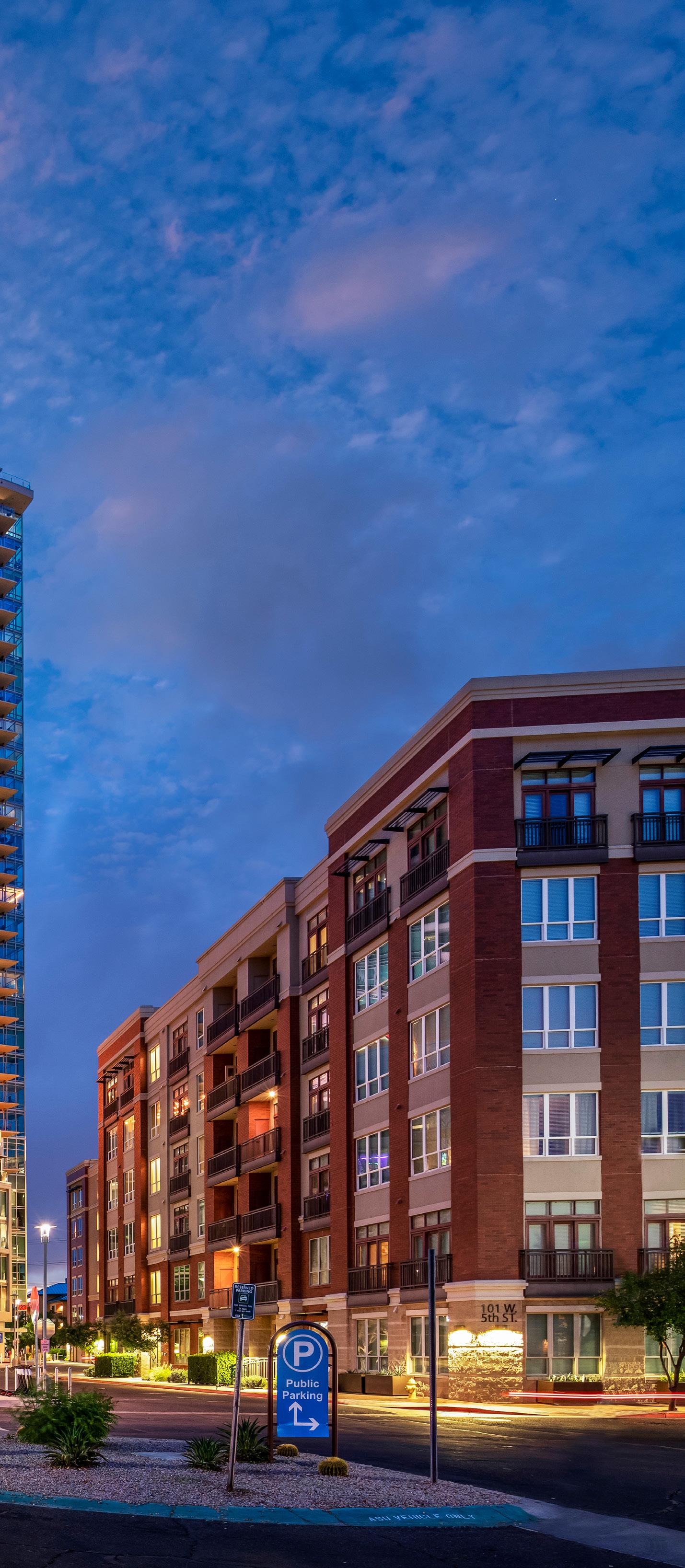
by RaeAnne Marsh
REAL ESTATE has always been a major part of our economy. And, as a lagging indicator whose thread weaves through businesses of every type, size and sector, it is also the perfect instrument with which to take the pulse of our economic health.
Looking at how the pandemic is affecting the market, Jonathan Keyser of Keyser, LLC says, “There’s a lot of impact that’s happening,” and observes, “Just in the overall commercial real estate market, you’re seeing vacancies rise; sublease space continues to hit the market. Real estate is a lagging indicator, not a leading indicator, and so we’re just starting to see rates start to decline.” He expects there will be more decline in pricing, and notes, “Delinquencies on loans is rising across the sector.”
DISSECTING THE MARKET
In breaking the discussion down sector by sector as to how the pandemic is affecting the market, Craig Coppola, a founding broker with Lee & Associates, starts with the “top of the food chain, that we all want to see come to Arizona, more and more of it” — which is manufacturing. “In terms of job creation,” he says, “all economic development people want manufacturing. And [real estate professionals] want it, too. We’ve allowed a lot of it to go overseas for cost reasons, and we’re finding out that might not necessarily have been a good situation for the country of America.” But he notes conditions are not what they were. “There’s a dramatic change in technology, so one of the things I’ve been saying in terms of manufacturing coming back is, I believe there will be a lot of manufacturing coming back that has the ability to be technology-based. Technology-based manufacturing is going to come back in a fairly big way because we’re going to see a lot of robotics and those kinds of things, in addition to U.S. security issues” – in such things, he says, as antibiotics.
Viewed from another angle, “Sector-wise, e-commerce is driving the market, which makes the industrial sector extremely stable,” says Bob Mulhern, senior managing director with Colliers International in Arizona.
Industrial’s strength is not new. Notes Terry Martin-Denning, CEO and designated broker of NAI Horizon Phoenix, “Industrial real estate in Phoenix has outperformed other asset classes for several years.” What’s different now? “The pandemic has made everyone aware of the importance of a safe and reliable supply chain.
“The industrial real estate market is poised for continued growth as the United States moves toward bringing back manufacturing businesses that were moved to other countries for cheaper labor,” Martin-Denning

continues. “I expect there will be more ‘last mile’ distribution centers for groceries, produce and medical and hygiene supplies that consumers need quickly. Those new distribution centers are likely to be smaller and spread out throughout the metro area.”
In fact, there has already been an increase in distribution and “last mile” facilities. Coppola points to Amazon, which he calls a “gorilla”: “They’re leasing tons of space, they have tons of divisions. So, we’re going to see more industrial, and industrial will do well.”
In this regard, Mulhern notes that a focus on supply chain is attracting more companies to consider Arizona due to its proximity to both California and Mexico along with its reputation as a business-friendly state with a growing population of educated workers.
However, Keyser adds somewhat of a cautionary voice in noting that, while industrial has held up the most of all commercial real estate sectors, a lot of the short-term industrial demand was driven business pivoting to having everyone work from home and the accompanying need to get them supplies and materials. “A lot of warehouse space and industrial space that the demand rose for in the short term was driven by that. So, I think we’ll see some settling-out there.”
Next in line of strength comes multifamily. As Mulhern points out, “This is a basic need and, as a result of everyone sheltering in place, it has remained strong as a product type.” And rents have remained stable, he says, thanks to the CARES Act combined with our relatively low cost of living.
“And in Arizona,” says Coppola, addressing multifamily and housing, “housing is going to be good for us because we had less housing than we needed before the pandemic.” Construction came to a grinding halt, “so that

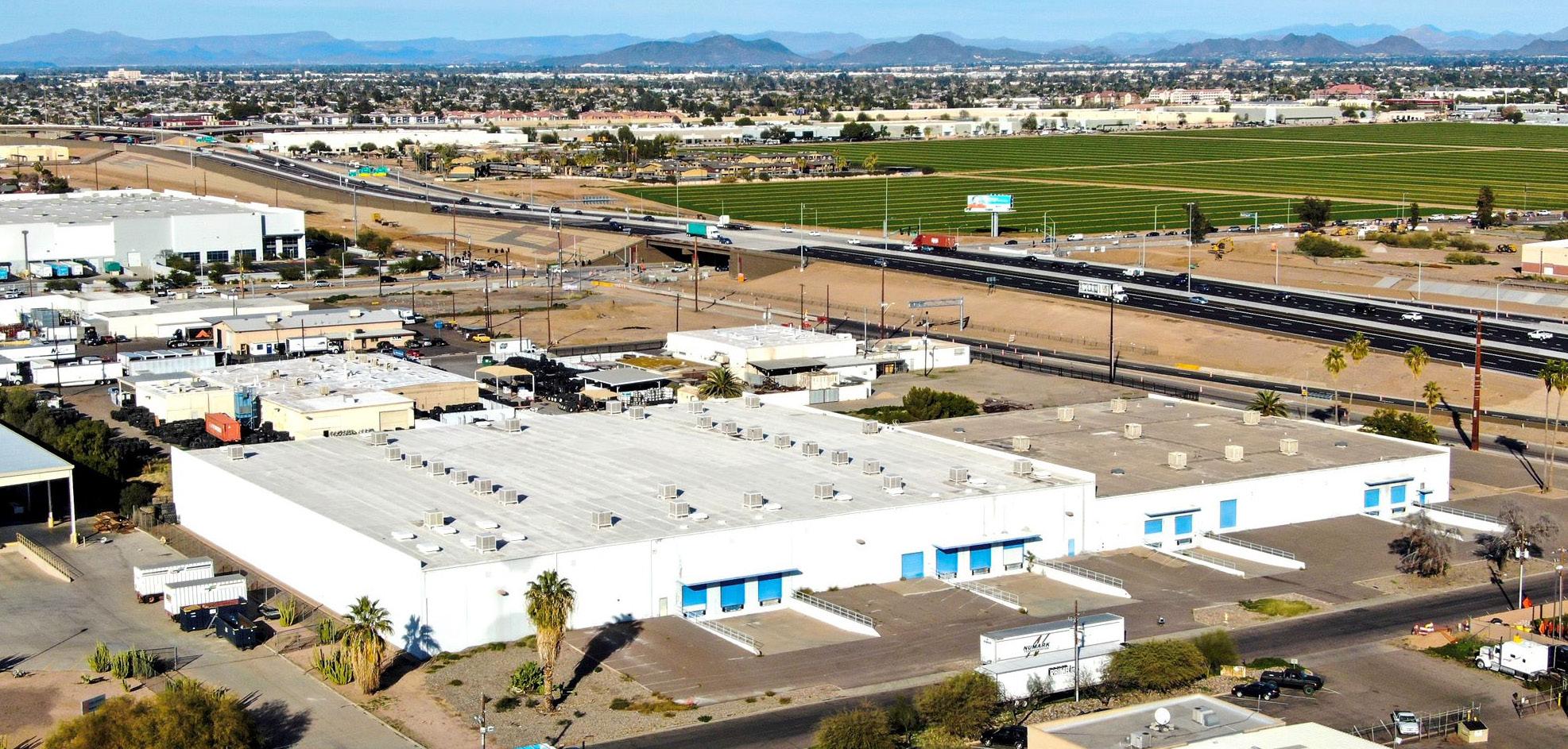
Industrial: distribution warehouse located at 2 N. 59th Avenue in Phoenix Photo courtesy of Marcus & Millichap

need is still there — and we’re going to increase it,” he observes, citing the fact that “the millennials continually get older.” He sees an increase in this area of real estate statewide and believes that will be good for all of Arizona as well “because we are in the business of growth.”
Office is where pain starts to manifest. Says Martin-Denning, “Now and for the foreseeable short-term future, the office market is moving slowly, with less new leasing activity than pre-pandemic.” Although asking rates have not as yet shown a decline, she believes there will likely be some softening as companies review their office workforce models. “The perperson office space requirement, from a square footage perspective, will expand. The ‘work-at-home’ model that the pandemic forced on businesses is likely to become a more common option in the long-term, especially for companies where employees work independently rather than in collaborative teams.” In the long-term, she says, “I believe the Phoenix office market will be resilient.”
Also remarking that businesses are considering less density and more flexible working policies and environments are being considered, Mulhern notes that companies are reconsidering their workspaces with the retention and recruitment of employees in mind. But he points to a few brighter spots. “Concerns about dense working submarkets, which we believe will continue to perform well, may provide some opportunities for suburban office options,” he says. “Medical space is also holding steady and, on the office side, there is good activity in the finance, insurance and tech spaces, depending on what verticals a company focuses on.” “It’s tempting to just get by right now,” observes Coppola. “If you’re not going to survive, then that’s a whole different conversation. But what I’ve found in our business, which is representing office tenants and landlords, it’s not nearly as dire as the retail tenants who have had to shut down and they’re still not open [at time of interview, May 18]. The office tenants, by and large, have some business going and are continuing that business. It’s more that they’re trying to be opportunistic as opposed to, ‘I’m really on the edge of my seat here. This could go a bad way if we don’t get the rent.’ And the landlords have tried to be opportunistic as well – ‘If I give you a couple
Office: Chandler Corporate Center in Chandler Photo courtesy of Colliers International of Arizona
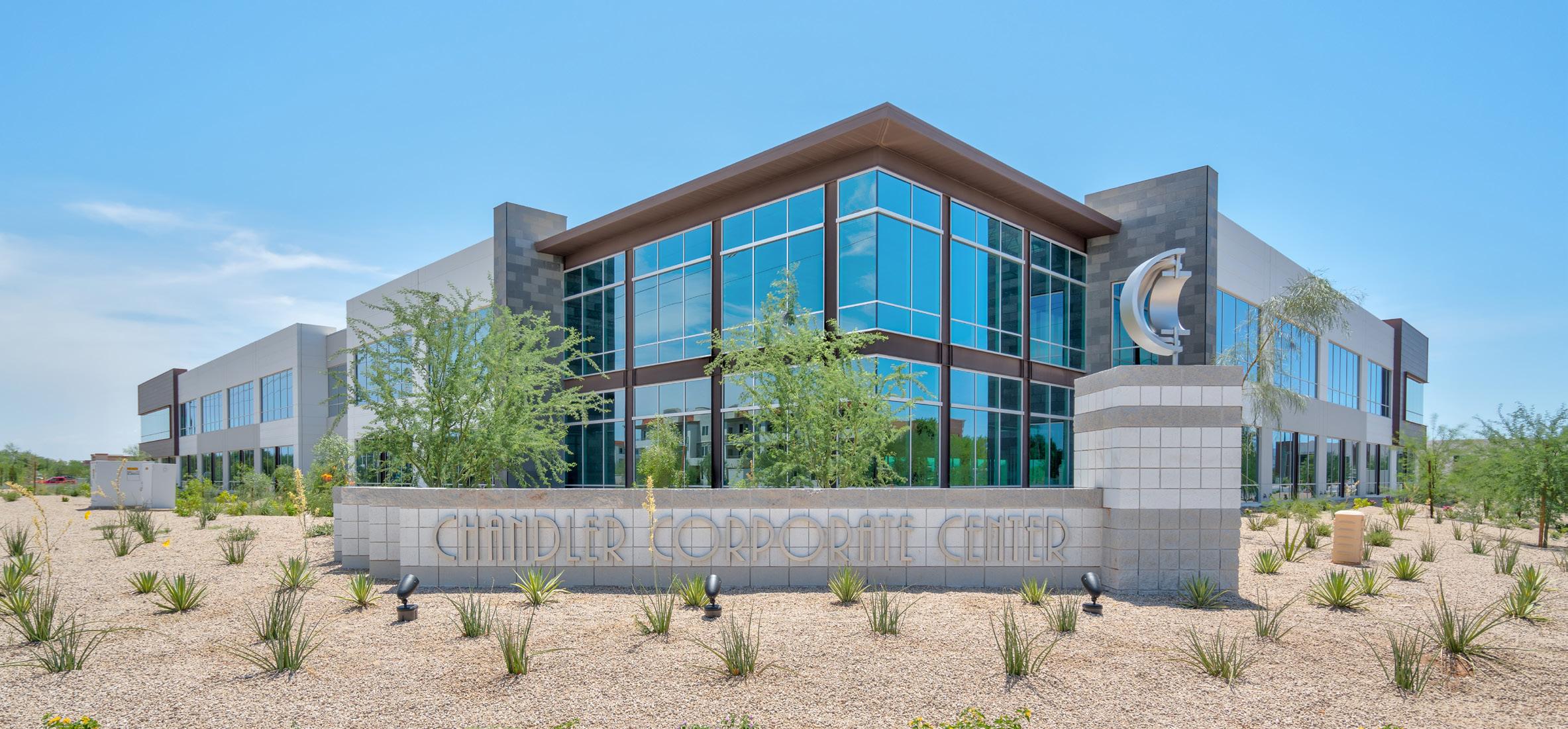

months free, then I want you to extend your lease another year.’” But office, he says, “will not be as hurt as retail.”
“Hammered” is the word Keyser uses to describe the pandemic’s impact on retail (and, he adds, on hotel kinds of product).
Regarding retail being the hardest-hit sector, Mulhern finds those businesses are still working through strategies to serve the public’s changing shopping mindset. Restaurants, he believes will have the most difficulty surviving as the economy opens back up for business.
Pointing out that big-box retailers and department stores were already struggling when the pandemic hit, Martin-Denning notes, “Most of the new retail developments under construction in Phoenix are continuing to move forward and some savvy tenants have used the ‘shut-down’ to build out new space to be ready to open when the lockdown is over. Phoenix has a large ‘foodie’ culture, and restaurants that are smart and creative are likely to fare well once people are able to go out to eat. The creativity of some businesses and their ability to pivot quickly to adapt to the social distancing rules has been impressive. Those businesses and new ones will survive and thrive. The businesses that were already struggling and were not able to adapt will likely close, opening up the opportunity for new concepts that work better in the post-pandemic retail environment.”
“Nobody pro formas 100-percent loss in your business for 60 or 90 days,” Coppola observes. So, what may be upcoming? Says Coppola, “The trend has been retail to entertainment retail — theaters, indoor sky diving, pitchand-putt golf, Top Golf — and who knows what that’s going to come back and look like, because that’s typically around other people. So, they’ll have to modify how they do it, and they can, but it’s going to take some time to do that.”
As to land itself as a real estate commodity, Mulhern says, “Since land transactions are more long-term in their nature, land transactions have seen the least disruption thus far.”
While occupants of real estate space are the visible face of the market impact, landlords are no less impacted. Says Martin-Denning, “Landlords in Phoenix have been faced with challenges working out rent relief with
tenants while at the same time working with their lenders for some relief on their debt service that will allow them to help the tenants get through this crisis. This is especially prevalent in the in the retail sector. We have helped our clients develop creative strategies to retain tenants and maintain the financial health of their properties for the long-term. The second round of the PPP loan program benefited more of the tenants in the properties NAI manages, allowing tenants to re-open and begin paying rent.”
Overall, says Mulhern, “Arizona’s rent collection thus far in the pandemic, in all product types, has exceeded early expectations, and we are faring better than many other markets. The more active and communicative the owner, the better the collections have been.”
It’s important to note, however, as Coppola points out, “Owners got nothing in the CARES Act. This is hurting owners, especially retail.”
Regarding real estate investment, Ryan Sarbinoff, Marcus & Millichap’s vice president and regional manager for Arizona & New Mexico, shares, “We have experienced a wide variety of investor responses to this pandemic. Some investors see this as an opportunity while others are taking a ‘wait and see’ approach.” The biggest changes his office has experience center on financing. “Early on, many lenders pulled back on loan dollars for asset classes they felt would be most affected. Up front reserve accounts required buyers to have additional equity to close, and negatively impacted cash-oncash returns in the early months of ownership. As a result, we have seen a flight to quality, with investors seeking quality assets with predictable cashflows and strong guarantees. Some investors pulled away from valueadd opportunities due to additional capital requirements and difficultly supporting assumptions such as absorption, occupancies, and future rents.”
Although it’s too early at this point to predict how the pandemic will affect the market in the long-term, there are challenges and trends that have begun to emerge.

CHALLENGES
“Getting back to work seems easy, but in some locations there are challenges that companies will have to face that will either put them in a position to keep their workforces remote through at least the end of the year or phase them back into the office,” says Ruth Darby, a licensed real estate agent with Keyser, which is part of Exis, a global commercial real estate organization committed exclusively to representing tenants and end users. “In cities like Phoenix or even Seattle, though at varying levels, there will be fewer challenges depending on how much or how little your city relies on public transportation to get your employees back to the office.”
Darby notes that in cities like New York, London or San Francisco, where the bulk of the employees rely on public transportation, getting everyone to work is literally impossible due to the inability for buses, subways and trains to load up to full capacity due to social distancing rules requiring less riders per trip. In fact, some companies are citing issues in getting even 10–15 percent of their employees back to the office. “Coupled with new standards inside the office, the challenge is compounded, as once you get the employees to the office there will need to be additional rules and regulations to comply with that are going to require more space per employee.
“Add on top of that the unknown liability issues that have yet to be brought to the surface of employers providing a safe work environment. For this reason, some of the larger firms are opting to stay with their work-from-home initiatives at least through the end of 2020 as they try to figure out how to manage these new challenges and new rules.” Nor is that all. “Another consideration at the forefront of all of these decisions,” she says, “is how will we keep our culture intact while we navigate all of these new challenges.”
Office: Playa Del Norte in Tempe Photo courtesy of Lee & Associates
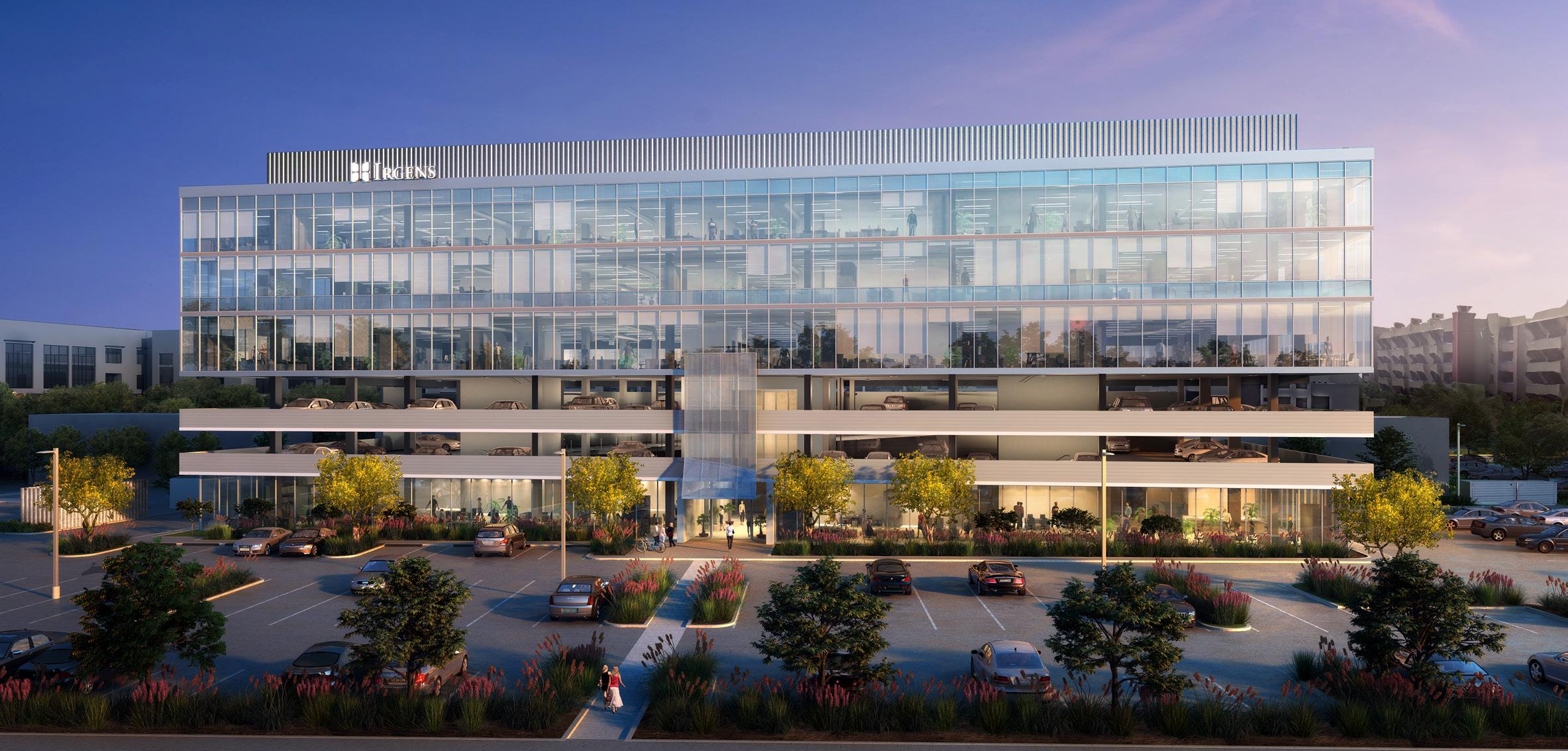


TRENDS
Coppola believes the pandemic will also make itself felt by accelerating trends that were already happening. One of those is flexible hours. “Flexible hours were just happening. Now, we’re going to see that happen faster. If you wanted to work from home one or two days a week, that’s going to happen now. You couldn’t do that before, but I think now people are going to say, ‘OK, I can allow that.’ So that’s going to happen.
“Along with that is what we’ve all gone through, which is the technology. If you hadn’t been working from home, you had to get the technology up to speed, and it happened really quickly, and so now everybody has the technology.” Coppola anticipates office space users will continue to use that technology to either let people get remote or just hire people remote.
“Remote work will become more widespread,” says Darius Green, a founding member of Keyser, who suggests it may help startups hire faster by bringing on people who live in other cities. “But this point is not limited to startups,” he says. “In fact, remote working may be an easier tool for established companies. Yes, a greater recruiting reach and deeper talent pool is a positive of remote working. But retaining a staff of digital nomads, having a lack of community or culture in the organization along with loss of productivity and security are challenges that remote working presents — which mature companies or startups with experienced executives are better equipped to address.” It’s not going to be a fit for every business and every employee, he observes.
“More remote work for local employees should reduce the need for office space and ease traffic,” Green continues, “but in cities where public transportation is leaned on heavily, returning to work is still an issue.” He points to staggered schedules or shift work being used to combat this logistics challenge along with a phasing of employees based on essential need at the office and their individual vulnerability and willingness to return.
A complication with that approach, Coppola points out, is the fact that one of the reasons people were going to open offices was for collaboration. “The minute you go onto a shift, there’s no collaboration going on. People have been doing Zoom calls, but it’s not the same as doing it in person. There’s a learning curve that has to happen and a culture that has to be changed.”
Or maybe that learning curve would include recognizing when not to change. Daniel Klueger, also an Exis member — at The Tenant Agency in Washington, D.C. — relates, “In early March, when tenants began working from home and exploring new ways to collaborate, it worked out well and teams remained effective by way of technology. The pendulum has since shifted and we’re hearing more users looking forward to re-entering the workplace, noting that technology will never replace human interaction.”
Coppola also identifies a category of trends that people have been trying to do but haven’t been able to effectuate, and feels that now might now be the time to give them another try. “Some will probably take place now that weren’t really doing great before.”
One of these is hoteling. “People are going to work remote, but they want a little space in the office. It’s not theirs all the time, so they’re going to have a hotel space that they can go to.” Conceding that this has been tried a handful of times over the past 10 years but didn’t get a lot of traction, Coppola says, “I think it will effectuate this time.”
Hoteling is not the same as a co-working operation, which Coppola explains is just flexibility. “There is a huge disconnect between what
Retail: L A Fitness in Tucson Photo courtesy of Marcus & Millichap
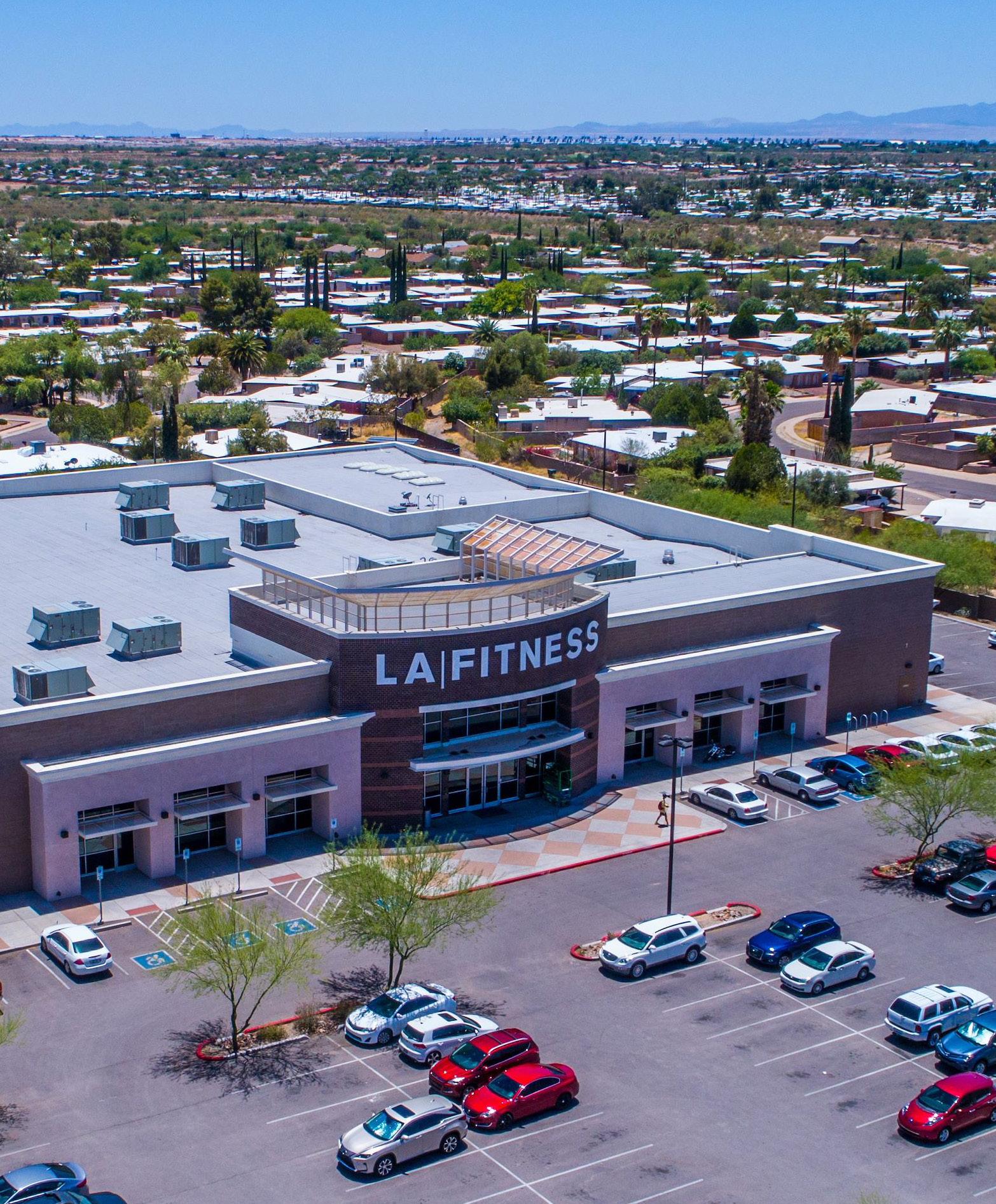

corporations want, which is shorter-term flexible leases, and what owners of buildings want, which is long-term stable leases. The WeWorks of the world were created for that second situation: They would find long-term leases on your behalf and sublease them.” In a hoteling situation, Coppola explains, “The property owner says, ‘We have room for 10 people, and we have 30 people who share it. There’s a cube there, but we’re just not letting for than 10 people a day come in.”
Another idea that has been around but Coppola feels may finally get its day is “remote workers anywhere.” This refers to employees who are interviewed and hired without anyone at the employing company actually meeting them. And they could be in a completely different city, being hired in Phoenix, for instance, while living in Cincinnati. “We’ve been seeing that happen, but not as much as I think we’re going to start seeing it,” says Coppola, relating, “We’ve been seeing it happen overseas. I know some accounting firms that have full-time employees in Bangladesh. I think we’ll see more globalization from these remote workers.”
In that regard, Klueger says, “Remote work will become more widespread and may help startups hire faster by bringing on those people who live in other cities.”
Trends in actual use of office space Coppola qualifies as uncertain, whether that’s a company going completely virtual or simply taking less square footage. “They may have fewer employees, or employees may
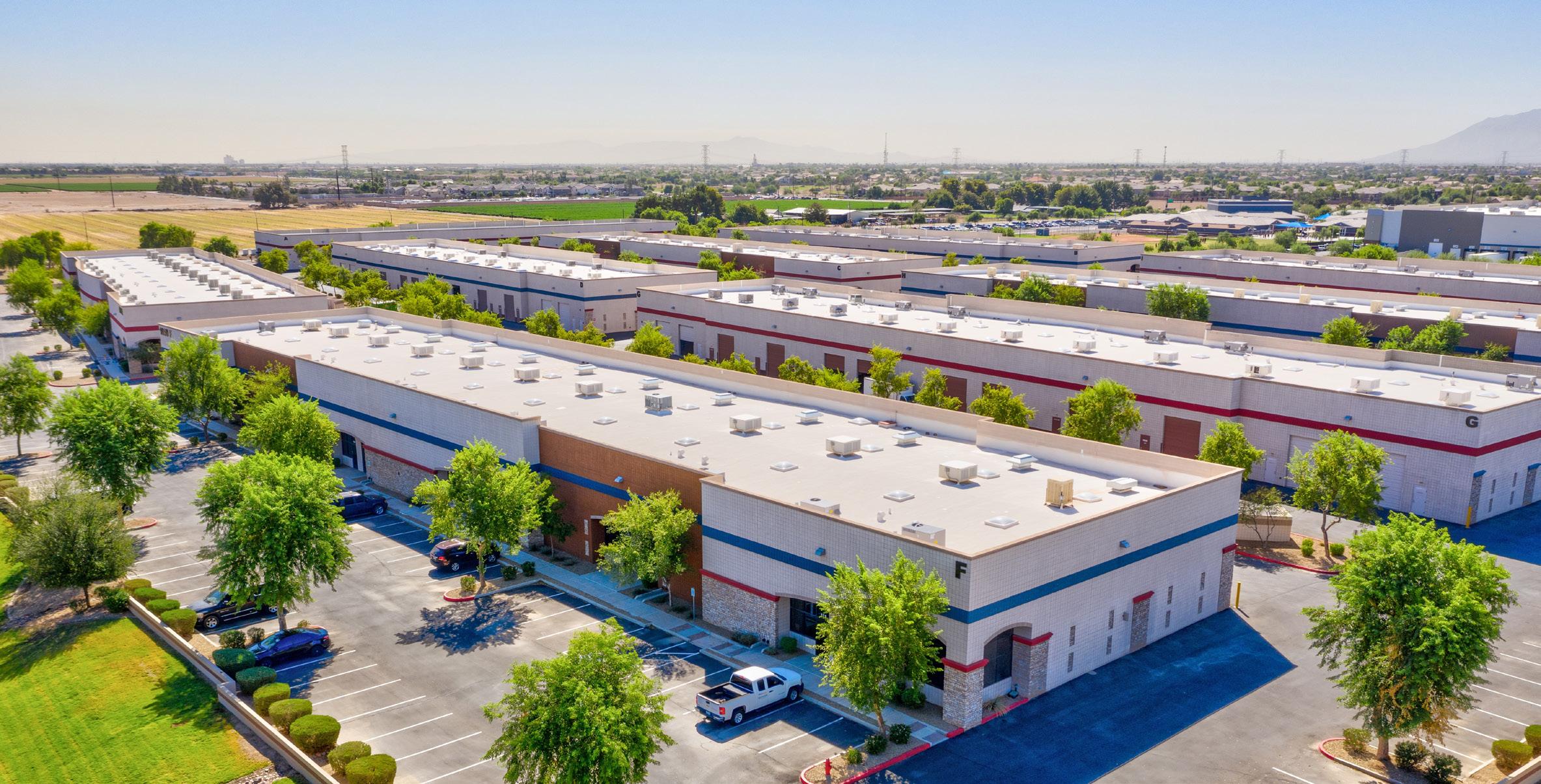
be remote, but now they’re going to have to design the office space so employees are not within six feet of each other. Companies might even go back to more private offices; that’s one way to keep safe and socially distant,” Coppola says.
Relates Green, “Our clients that are in the market to relocate or renew are definitely looking to reduce their footprint and re-imaging their work environment. For the companies that have realized that the forced remote working experience generally works for their business, the focus in their new space requirements is having defined space for key executives, operations and any key departments where working remotely does not
Manufacturing: Erickson Construction in Chandler Photo courtesy of Marcus & Millichap
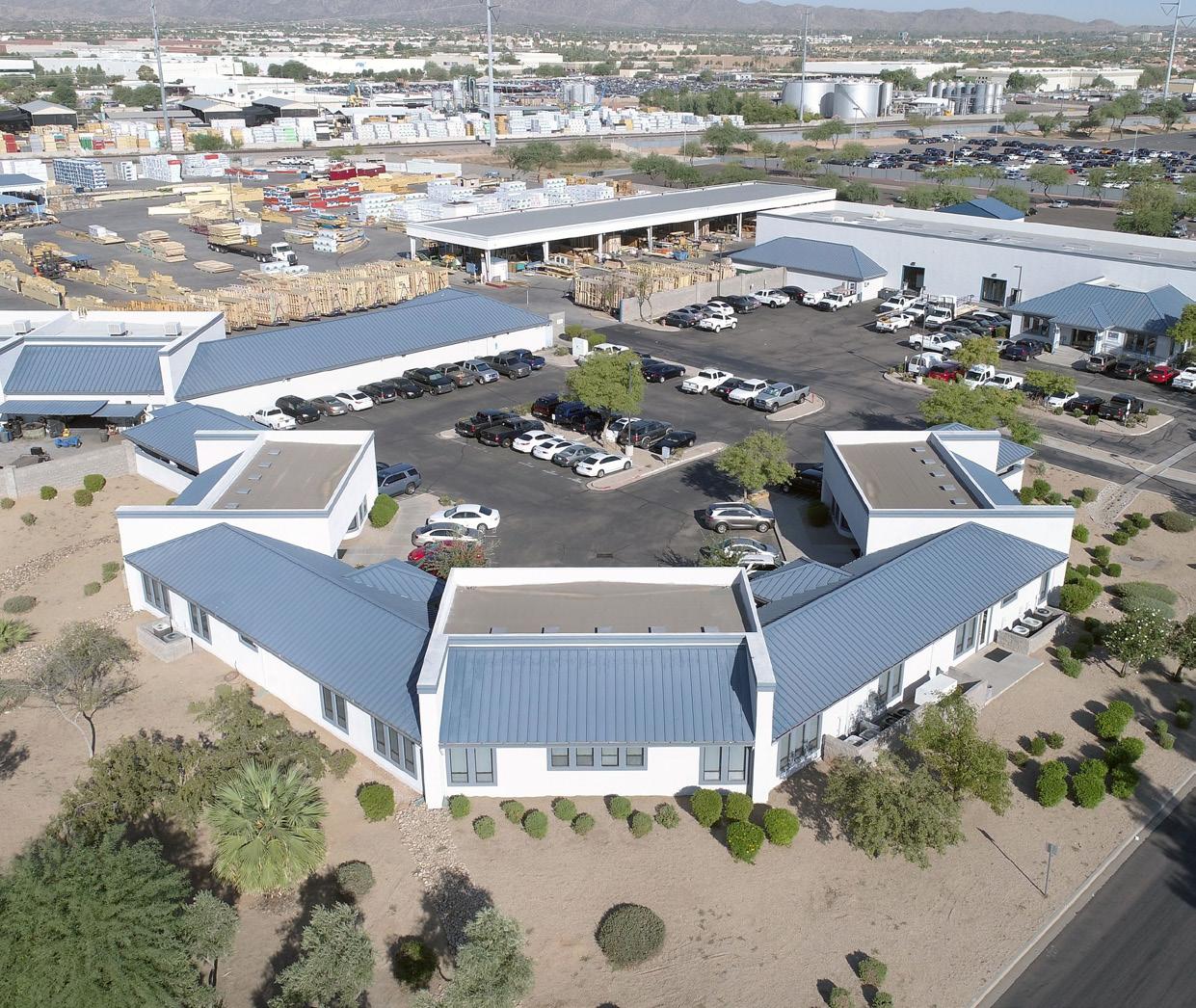


Industrial: Avondale Commerce Center in Avondale Photo courtesy of Colliers International of Arizona

generally work and then focusing on flexibility for the remainder of the space, with various meeting rooms and touch-down/hoteling space for employees who generally work remotely to use when they need to come into the office.” What’s important for those companies not in the market currently, Green says, is to assess what is working and not working as we come out of the COVID-19 shutdown — but not overreact with their real estate plans when the opportunity comes. “They should also build in flexibility whenever possible from a term perspective as well as have the opportunity to expand if it becomes necessary years down the line when COVID-19 is, hopefully, a distant memory.”
Also expecting the layout of space will be re-imagined and office space may be used differently, Green says, “The office would function more as a meeting space.”
Regarding space needs specifically, Keyser says, “I think you’re going to see a lot less of the 8–5; you’re going to see more flex work. People are still going to need space — they’re still going to need offices, they’re going to need retail centers, they’re still going to need warehouses and manufacturing facilities. But I think that how they think about density, how they think about spacing, and at some level cleanliness — all that changes.”
“Likely, the answer will be a mixed bag of work-from-home, staggered schedules and compressed work weeks as well as satellite offices to accommodate employees located in the suburbs,” says Darby. “We have seen companies that have decided they are going to be 100 percent work-fromhome and others that are deciding how they are going to piece together what combination will work best based on what type of business they conduct and how important it is for the employees to be in the office.”
Are the trends going to be geographic or more broad-based? “We don’t know the answer yet,” Coppola says. “There was a huge trend for 20 years to the suburbs, and there was a huge trend over the last five years as the millennials came into the marketplace of going back to the urban core. And that’s the question: Are we going to see the trend continue to go back to the urban core or back to the suburbs? Nobody knows.”

CRE IS A BUSINESS SECTOR, TOO
The CRE firms are also businesses in their own right. Relationships built on expertise remains the foundation of their business, with both elements valued even stronger as the clients they serve reel from the pandemic’s disruption. So how is the pandemic affecting their operations? Their responses also give further insight into the market’s equilibrium.
“Lee & Associates has had no focus changes,” Coppola says, affirming the business is relationship-based. “Our clients need us now more than ever. And they want experience. While we have not ever lived through a pandemic, we have been in business since 1991, and worked our way through three major recessions.
“In the last three to five years, as the economy was rolling, a lot of inexperience and some poor decision-makings could be covered up because the economy was rolling and you were going along with the tide. And what happens when you have something as dramatic as this and as sudden as this is, people start looking for experience. They want to know somebody’s been through … not necessarily this, but something similar, like the RTC days in the late ‘80s and early ‘90s. [The Resolution Trust Corporation was a temporary federal agency created to resolve the savings and loan crisis of that time.] Or, in our case, 2008/9 /10, when we’d just had a great recession and that happened fairly quickly. And so, clients are looking for way more experience from us, and then we are sitting there at our end having to work with clients and holding their hands and talking through it because we’re both experiencing this at the same time and there aren’t any answers.
“This morning,” Coppola continues, “I was on the phone all morning talking to a couple of tenants we represent, just going through options and how we’re going to handle it and what the pros and cons are and the shortterm effects and how it could affect the long-term. We’re doing a lot more hand holding, more consulting, a lot more of just bringing people to a place of comfort about where they are.
“The relationship is trust. And trust on both ends: that we’re not out for the quick dollar and that we’re going to give them fair and sound advice, not [just] something that they want to hear. Like the calls this morning, tenants saying, ‘I just want to walk away from my lease.’ And you have to say, ‘That’s not a good strategy because you’ll have to file bankruptcy. And if you’re going to file bankruptcy, I get it, but if you’re just doing it because you want to save some rent, then you’re going to have to change your name, you’re going to have the landlord after you, and people are going to look at you differently when you rent in your next place.’”
Shares Mulhern, “Colliers’ International’s emphasis on strategic partnering with our clients has allowed us to realize significant momentum during this pandemic. Since we are focused on our clients’ business needs more than just their real estate transactions, we have been able to help a number of them make important business decisions over the past few months. We have also earned significant new business assignments due to our consultative mindset.”
“Our culture as JLL brokers has always been to serve as knowledgeable
Retail: Deer Valley Center in Phoenix Photo courtesy of NAI Horizon Phoenix
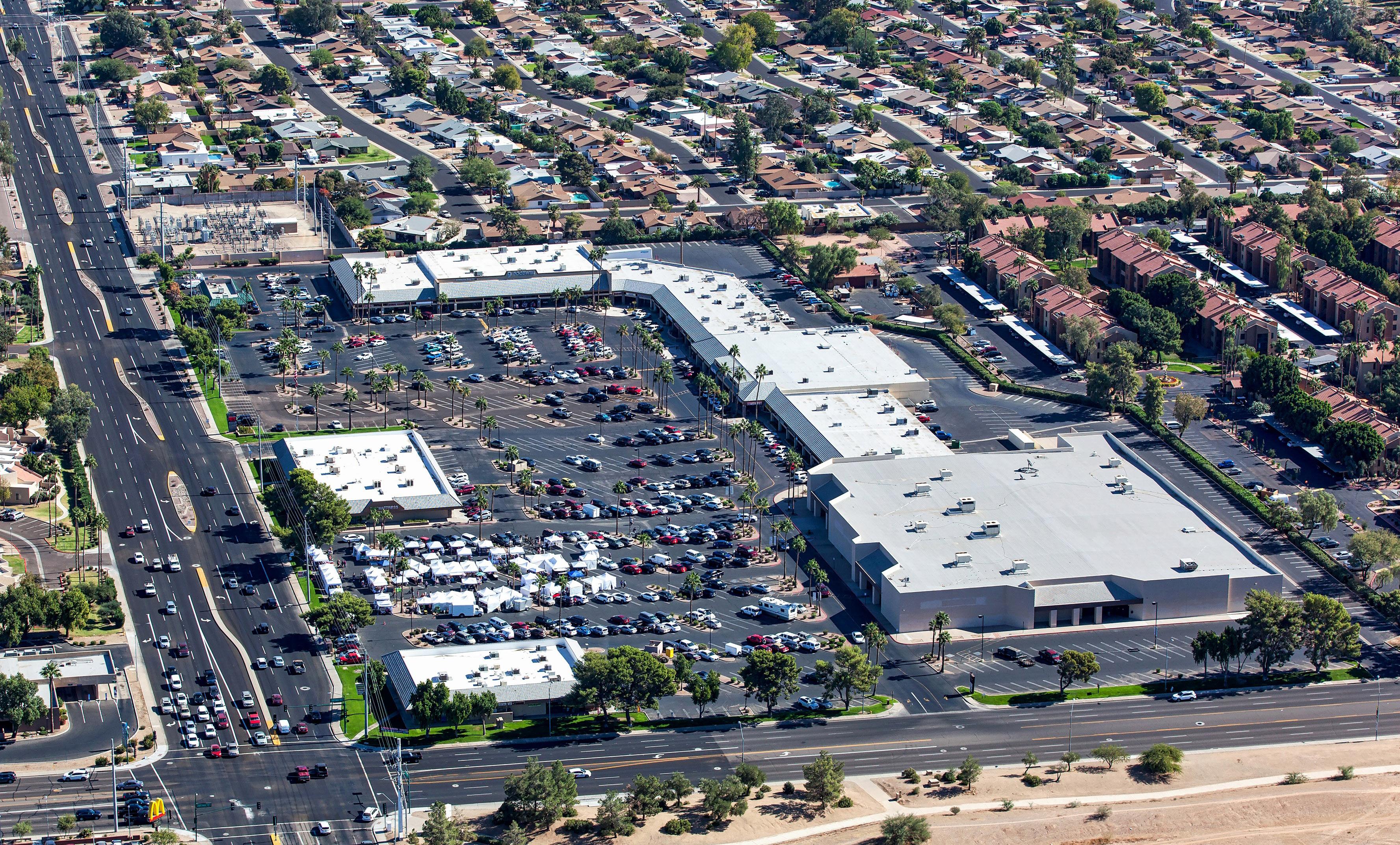

Multifamily: Harper in Tempe Photo courtesy of Marcus & Millichap


advisors for our clients and to help shape the best possible future for commercial real estate,” says Ryan Bartos, managing director. “COVID has caused us to lean even heavier into that commitment. Tenants need our assistance with cash preservation strategies, landlords need guidance on rent relief protocols, and everyone is looking for best practices to keep buildings and employees safe and healthy. I expect that these concerns, particularly a focus on safety and stability, will continue as our market begins to re-open.”
At Keyser LLC, “We still have a lot of traditional business,” Keyser says. “We still represent tenants and help them find space.
There are a lot of sectors that are impacted less than others. End leases continue to roll, and companies continue to have to do something with that. So, we have a lot of just business that continues, and we have a lot of clients who are actually being benefited by this downturn.” In terms of purposeful changes by the firm, Keyser shares, “One of the biggest things we’ve done is pivot to helping organizations figure out rental relief. We’ve given webinars to help and coach and give and serve — to help orgs figure out how they navigate their commercial real estate in these crazy times. We’re also helping organizations strategically start thinking about how they can take advantage of the opportunities that are being created by this marketplace.”
“NAI Horizon has not changed its focus or business strategy in response to the pandemic,” Martin-Denning says. “In our roles as ‘trusted advisors’

to our clients, we have been spending a large amount of time helping our tenant and property-owner clients navigate the COVID-19 challenges. The mandated ‘shelter-in-place’ order all but eliminated in-person property tours, and conducting virtual tours became the norm. The most cautious business owners and investors who did not have an immediate need, hit the pause button, waiting for more information about how the pandemic will affect real estate and the economy long-term. Clients who wanted to open in a specific location moved forward with their transactions, and investors with cash to invest continue to buy properties where the numbers make sense.”
At Marcus & Millichap, says Sarbinoff, “We have been entirely focused on the human element of this pandemic. Our number one priority remains serving clients. We want to ensure our investors and their tenants maintain a safe, clean environment. That has not changed and never will. What has changed is our execution. Our efforts now center on providing our clients with up-to-date information on trends and changes that affect them directly. Due to the uncertainty surrounding the world economy, real-time data regarding operations and investments is more valuable today than ever before. Our research department has responded by producing more than 50 special reports pertaining to every asset class. Furthermore, we have coordinated more than a dozen internal market response workshops and live client investment forecasts to help identify trends and best practices.”

LOOKING AHEAD
“Arizona is in a strong position to rebound better than many other states,” says Mulhern. “Our momentum going into the pandemic, our steady leadership through the economic shutdown, and our draw as a businessfriendly state are all working in our favor.”
In fact, he adds, “Arizona is benefiting from the strict regulations put in place by other states. People who have means are choosing to relocate to Phoenix. The fact that we were able to keep a lot of our industry open and quickly re-open the ones that were shut down has worked in our favor. Also, the diversity of our economy is showing our ability to weather storms more effectively than we have in the past.”
COVID-19 brought most transactions to an immediate pause in March and April, but Bartos noted an uptick in interest as soon as Phoenix began its phased re-opening in May. Now, he relates, “While market activity is not nearly as robust as it was 90 days ago, we’re actively working with our clients as they prepare for re-entry, and JLL has developed a Return-to-Work Guidebook outlining best practices for transition to the ‘next normal.’”
Bartos’ overall experience is that companies are moving forward. “We expect to see some lag in the market but, in general, Phoenix remains an attractive place to do business. We’re working right now with several big clients from major U.S. markets who are expediting their search here because, long term, they believe that our access to labor, cost of doing business, transportation infrastructure and quality of life make us the place to be.”
Bartos believes it’s too early to formulate conclusions on the ultimate impact of COVID on our industry or our market, but he believes that – even in light of today’s challenges – Phoenix is in a good position. “We entered into the last recession with a significant amount of speculative product and it took us a long time to absorb that space. This cycle, we have maybe onethird of that speculative inventory and a much more diversified economy that includes not only real estate but also medical, tech and finance. We were in a strong position going into this pandemic and that gave us a great foundation from which to emerge strong.”
Phoenix and, in fact, the western United States are better positioned for a strong recovery than many parts of the country, says Martin-Denning. The Great Recession hit Phoenix very hard, but she points out that since then, Phoenix has expanded and grown a very diverse economy with a highly educated workforce, making it attractive for industries not previously prevalent in Phoenix. Higher education, health care, financial industries, engineering, manufacturing, distribution and aerospace all have a large presence in the area. Concluding, “Phoenix is business-friendly and remains one of the fastest-growing cities in America,” Martin-Denning says, “I remain optimistic about the recovery of the overall economy and the long-term health of real estate in Phoenix.
“I remain hopeful that we will not be forced into another ‘stay-at-home’ period, and that the rest of the country continues to recover and reopen.” While it’s too early to predict the long-term impact of the pandemic on business, Martin-Denning notes our economy was strong with good liquidity going into this crisis. “Because of that, I believe we are likely to have a strong recovery with businesses that adapt well and quickly to the ‘new normal’ coming through the crisis stronger and better positioned for the long-term.”
Sarbinoff also emphasizes that it remains too early to tell the pandemic’s impact on business. “Real estate is reactive in nature,” he explains. “Therefore, we do not expect to see movement in pricing for at least six months after the bane. With that said, today more than 36 million Americans are out of work. This is a staggering number and must be our focus moving forward. Positive job and wage growth remain critical components to economic expansion. Tenants’ inability to pay rent will negatively affect cash flows and subsequently values of real estate assets.”
Looking beyond the immediate, Sarbinoff says, “We are entirely focused on the month of August. The CARES Act and expanded unemployment benefits are set to expire, and kids are due back to school. These results will determine the depth of the negative impact and trajectory of our recovery. If parents go back to work and kids go back to school, we’re on the right path.”
Colliers International in Arizona colliers.com JLL jll.com Keyser LLC keyserco.com Lee & Associates lee-associates.com Marcus & Millichap marcusmillichap.com NAI Horizon Phoenix naihorizon.com The Tenant Agency thetenantagency.com

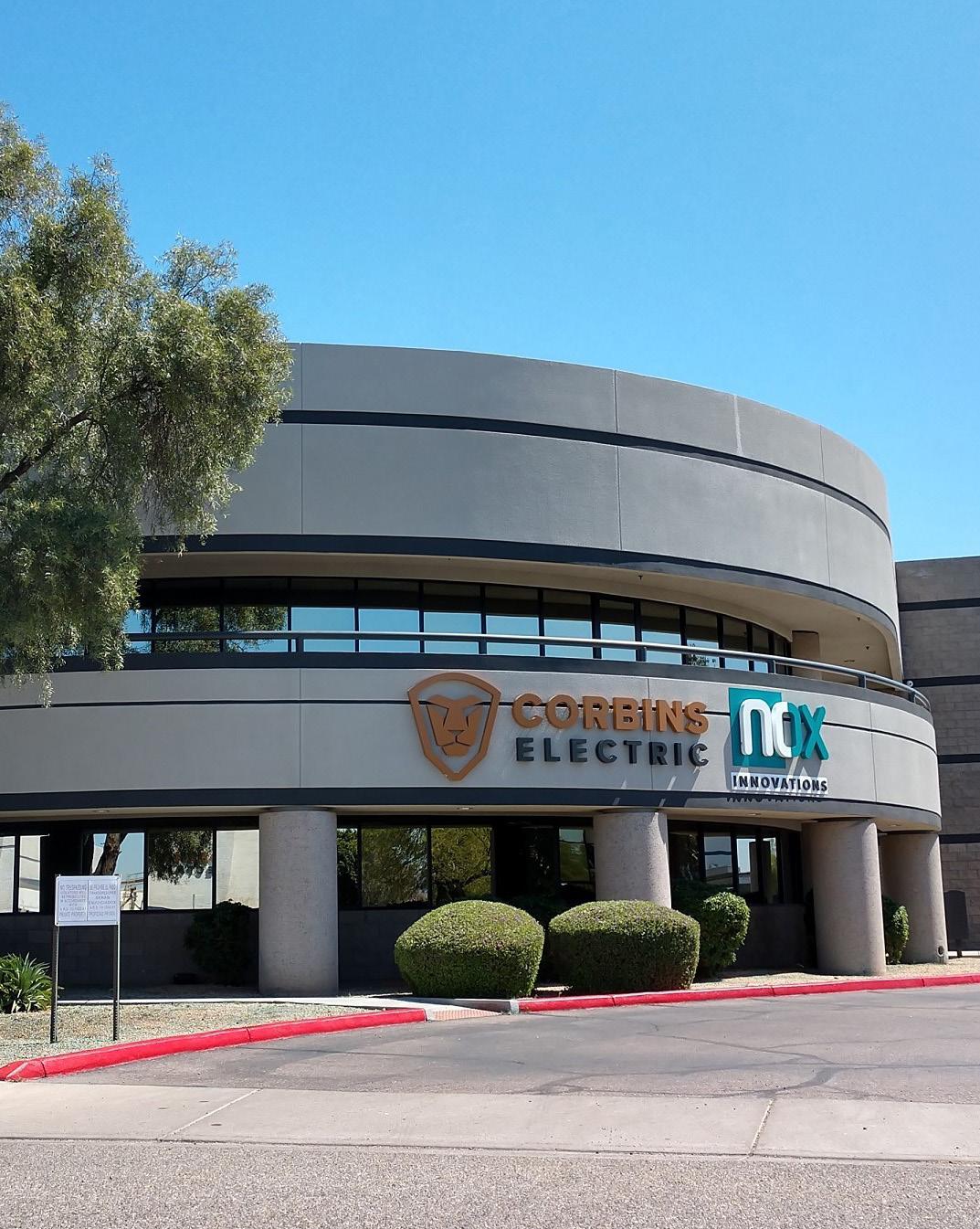
Industrial: Corbins Electric in Phoenix Photo courtesy of NAI Horizon








